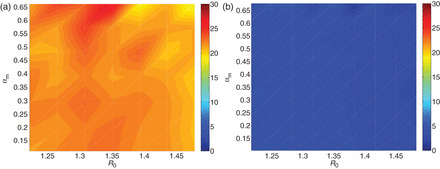Fig. 3.

The average percentage change in the time-of-peak of the epidemic with school-based measures under two assumptions on mixing. The start time and duration of the intervention are randomly sampled over plausible ranges as described in the Supplementary data. (a) Enhanced child–child mixing assumption. The underlying age-dependent mixing between children is assumed to be enhanced compared with between adults. Measures to reduce child–child mixing result in an appreciable delay to epidemic peak, constant in percentage terms at around 20%. Note that for increasing R0, the time to peak shortens and thus so does the absolute delay achieved by the intervention. (b) Homogeneous mixing assumption. The underlying age-dependent mixing is assumed to be uniform. A reduction in child–child mixing has (on average) a negligible effect on the epidemic regardless of assumed transmissibility or severity.
